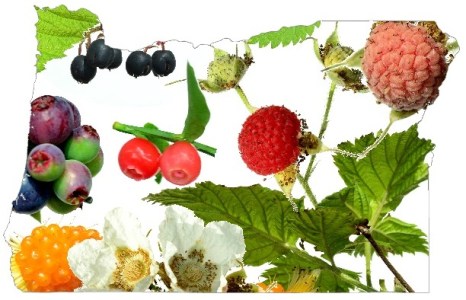Common Name – Chickweed
Genus – Stellaria
Species – media
Family – Caryophyllaceae
Edible Parts – Leaves, flowers and tender stems (top 4in).
Harvest – Leaves and stems; late winter – early summer, again throughout fall.
Habitat – Very widespread; moist soil, shade – full sun; woodlands, parks, curbsides, garden beds, vacant lots, roadsides; low – middle elevations.

In Oregon
and most of North America, Chickweed is commonly seen practically anywhere there are people. It thrives in disturbed soils where people have left their mark and it’s for this reason that Doug Benoliel in the book Northwest Foraging calls it the “People Plant”. One of the many advantages of Chickweed is its ability to grow nearly year round only dying back during extreme adverse conditions such as prolonged heat and drought or sub freezing temperatures. During the rest of the year it’s found growing in thick mats sometimes completely taking over abandoned garden beds. It thrives in moist soil with partial to full sun. Like most wild edibles the more preferable its growing conditions are the more likely it will be tender and less bitter.

When eating
the flavor can be described anywhere from something less desirable such as straw, to a more choice flavor such as spinach or lettuce. Again this all depends on the plant you choose to harvest. Those growing in dry-cracked soil with the blazing sun beating on them will tend to will be limp, have stringy stems and be more grassy, lacking good flavor. Look for plants in more favorable growing conditions. This is evident by the overall lushness of the plants and the dark green pigmented leaves. Such plants will be crisp, juicy and tender, full of good flavor. Typically the top four inches is where you’ll want to harvest – this includes the leaves, flowers, and stem. Cutting lower than this will make it harder for the plant to recover for your next harvest, and the stems at this point will be too fibrous to be enjoyed anyway. According to John Kallas in his book Edible Wild Plants it usually takes no more than 2 – 4 handfuls for an individual salad. His recommendation is to use Chickweed as you would lettuce or alfalfa sprouts when creating dishes. He shows an assortment of creative dishes that would make anyone feel privileged try wild edibles.

Identifying
can start with Chickweeds genus name Stellaria. In Latin Stella means Star which can be seen by the tiny white flowers of Chickweed that resemble a starburst.  Another identifiable feature is the unique hair pattern of Chickweed. Unlike its look-alikes, Chickweed only has a single line of hairs growing down its stem, shifting a quarter turn between leaf sets. This feature is unique only to Chickweed of the Stellaria genus. Some of its other “imposters” such as the poisonous Scarlet Pimpernel produce brightly reddish colored flowers, have a square stem and lack any distinguishable hairs. Since both Scarlet Pimpernel and Chickweed may be found growing in garden beds use care not to accidentally mix the two during harvest.
Another identifiable feature is the unique hair pattern of Chickweed. Unlike its look-alikes, Chickweed only has a single line of hairs growing down its stem, shifting a quarter turn between leaf sets. This feature is unique only to Chickweed of the Stellaria genus. Some of its other “imposters” such as the poisonous Scarlet Pimpernel produce brightly reddish colored flowers, have a square stem and lack any distinguishable hairs. Since both Scarlet Pimpernel and Chickweed may be found growing in garden beds use care not to accidentally mix the two during harvest.
With the exception of a stray look-alike mixing into the batch, Chickweed itself is very easy to identify. It’s delicious to most, very nutritious and found in abundance most of the year. For this reason it’s a wild edible worth adding into your repertoire of plant food. So the next time you find yourself pulling up this “weed” why not set it aside and have it with dinner?
Nutritional Content
Per 100 grams raw Chickweed
RAE 50 mcg
B-car 600 mcg
Ca 73 mg
Fe 3.00 mg
Zn .590 mg
Cu .120 mg
Mn .290 mg
Bibliography
 Edible Wild Plants by John Kallas
Edible Wild Plants by John Kallas
 Northwest Foraging by Doug Benoliel
Northwest Foraging by Doug Benoliel
 Plants of the Pacific Northwest Coast by Pojar & Mackinnon
Plants of the Pacific Northwest Coast by Pojar & Mackinnon
**photo’s by Henry Holly, copyright 2018**
